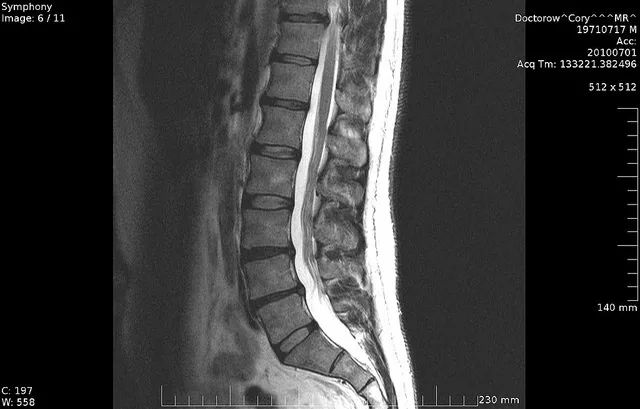So, your back’s been hurting. You saw your doctor. He sent you to get a MRI and now you have the report. Unfortunately, the report may use medical terms that most of us do not use everyday. This blog will discuss the meaning of the medical words you may see listed on that report.
Understanding MRI Reports Cervical Spine
If the MRI report relating to your back and neck is discussing the LUMBAR spinal it is referring to your low back. If it is discussing the CERVICAL spine it is referring to your neck. Finally, if it is about the THORACIC spine, it is discussing from the bottom of the neck to your low back. Sometimes, an x-ray of the spine may include information about the COCCYX or the SACRUM. The sacrum is that fused bone just below your waist and the coccyx is the tail like thinner section.
The MRI may refer to C4 or L5. What does this mean? As mentioned in the paragraph above, the back and neck are divided into sections. So C4 would refer to the cervical part of the spine (neck) and the 4th vertebrae and L5 would refer to the lumbar part of the spine (low back) and the 5th vertebrae. The cervical portion of the spine has seven vertebrae, the thoracic section has twelve vertebrae and the lumbar section typically has five vertebrae. The number of vertebrae in the neck typically remains unchanged but some people may have one extra or less in the thoracic or lumbar section. While some people may have an additional vertebrae in one section, typically the overall number of vertebrae remains the same.
If you see the term, L3-4 in the report or something similar, it is referring to the intervertebral discs, in other words, indicating what is happening is occurring to the disc both above and below. At times there will be two letters involved like L5-S1 which means the last vertebrae of the low back and the first part of the sacrum.
If your report states you have an ANNULAR TEAR this means that the disk which filled with a jelly-like substance has torn open. The tear causes the jelly-like substance to gradually leak out. This tear and subsequent leak causes a condition called a HERNIATED DISC. Other conditions associated with this may be called DISC BULGE, DISC EXTRUSION, or DISC PROTRUSION. Besides pain, a person with these diagnoses may experience symptoms such as numbness, tingling, loss of flexibility, or a weakness to the extremities (arms or legs.) These injuries may also cause SCIATICA which is when pain radiates from the low back down the buttocks, hips or legs. Not everyone with this diagnosis will experience exactly the same symptoms or severity of symptoms. The severity of the disc compression may be evident by the intensity of the symptoms previously mentioned.
MRI Of The Spine And Neck
It should be noted that both laymen and medical providers may use the word disc bulge, extrusion, or protrusion interchangeably. This does not mean that they are the same thing but since symptoms may be similar and a medical provider may spend an entire day reading reports he or she may unintentionally use the wrong term. Unfortunately, this may occur not just when a medical provider speaks but also in reports. Make sure you confirm with the doctor your exact diagnosis.
Sometimes a person experiences severe extremity pain, pain in the arms or legs, after trauma to the spine. Why? This is because the branch like structures up and down the spinal cord are actually nerve roots which shoot to different parts of your body. If the disc is herniated or bulging there is an excess pressure being placed on the nerve root which will cause ‘shooting’ pain in the extremities.
If you have been involved in an accident of any sort that has resulted in serious trauma to your spine, you may have rights to compensation. Our office, Edward A Smith Law Offices, has successfully handled thousands of claims related to neck and back injuries. To discuss your claim, please call our office for a free consultation. We can be reached at (916) 921-6400 or (800) 404-5400. To learn how others who have used our services feel, see Yelp or Avvo.
Photo Attribution: By http://en.wikipedia.org/wiki/user:Vsion (Originally Vsion’s work) [CC0], via Wikimedia Commons

